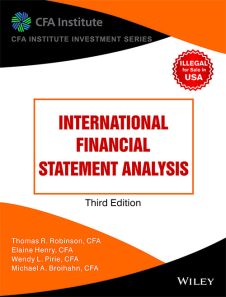International Financial Statement Analysis, 3ed (CFA Institute Investment Series)
ISBN: 9788126564767
1060 pages
Publication Year: 2016
For more information write to us at: acadmktg@wiley.com

Description
International Financial Statement Analysis provides the most up-to-date detail for the successful assessment of company performance and financial position regardless of country of origin. The seasoned experts at the CFA Institute offer readers a rich, clear reference, covering all aspects from financial reporting mechanics and standards to understanding income and balance sheets. Comprehensive guidance toward effective analysis techniques helps readers make real-world use of the knowledge presented, with this new third edition containing the most current standards and methods for the post-crisis world.
Preface
Acknowledgments
About the CFA Investment Series
Chapter 1 Financial Statement Analysis: An Introduction
1. Introduction
2. Scope of Financial Statement Analysis
3. Major Financial Statements and Other Information Sources
4. Financial Statement Analysis Framework
5. Summary
Chapter 2 Financial Reporting Mechanics
1. Introduction
2. The Classification of Business Activities
3. Accounts and Financial Statements
4. The Accounting Process
5. Accruals and Valuation Adjustments
6. Accounting Systems
7. Using Financial Statements in Security Analysis
8. Summary
Chapter 3 Financial Reporting Standards
1. Introduction
2. The Objective of Financial Reporting
3. Standard-Setting Bodies and Regulatory Authorities
4. Convergence of Global Financial Reporting Standards
5. The International Financial Reporting Standards Framework
6. Effective Financial Reporting
7. Comparison of IFRS with Alternative Reporting Systems
8. Monitoring Developments in Financial Reporting Standards
9. Summary
Chapter 4 Understanding Income Statements
1. Introduction
2. Components and Format of the Income Statement
3. Revenue Recognition
4. Expense Recognition
5. Non-Recurring Items and Non-Operating Items
6. Earnings per Share
7. Analysis of the Income Statement
8. Comprehensive Income
9. Summary
Chapter 5 Understanding Balance Sheets
1. Introduction
2. Components and Format of the Balance Sheet
3. Current Assets and Current Liabilities
4. Non-Current Assets
5. Non-Current Liabilities
6. Equity
7. Analysis of the Balance Sheet
8. Summary
Chapter 6 Understanding Cash Flow Statements
1. Introduction
2. Components and Format of the Cash Flow Statement
3. The Cash Flow Statement: Linkages and Preparation
4. Cash Flow Statement Analysis
5. Summary
Chapter 7 Financial Analysis Techniques
1. Introduction
2. The Financial Analysis Process
3. Analytical Tools and Techniques
4. Common Ratios Used in Financial Analysis
5. Equity Analysis
6. Credit Analysis
7. Business and Geographic Segments
8. Model Building and Forecasting
9. Summary
Chapter 8 Inventories
1. Introduction
2. Cost of Inventories
3. Inventory Valuation Methods
4. The LIFO Method
5. Inventory Method Changes
6. Inventory Adjustments
7. Evaluation of Inventory Management
8. Summary
Chapter 9 Long-Lived Assets
1. Introduction
2. Acquisition of Long-Lived Assets
3. Depreciation and Amortization of Long-Lived Assets
4. The Revaluation Model
5. Impairment of Assets
6. Derecognition
7. Presentation and Disclosures
8. Investment Property
9. Leasing
10. Summary
Chapter 10 Non-Current (Long-Term) Liabilities
1. Introduction
2. Bonds Payable
3. Leases
4. Introduction to Pensions and Other Post-Employment Benefits
5. Evaluating Solvency: Leverage and Coverage Ratios
6. Summary
Chapter 11 Financial Reporting Quality
1. Introduction
2. Conceptual Overview
3. Context for Assessing Financial Reporting Quality
4. Detection of Financial Reporting Quality Issues
5. Summary
Chapter 12 Financial Statement Analysis: Applications
1. Introduction
2. Application: Evaluating Past Financial Performance
3. Application: Projecting Future Financial Performance
4. Application: Assessing Credit Risk
5. Application: Screening for Potential Equity Investments
6. Analyst Adjustments to Reported Financials
7. Summary
Chapter 13 Income Taxes
1. Introduction
2. Differences between Accounting Profit and Taxable Income
3. Determining the Tax Base of Assets and Liabilities
4. Temporary and Permanent Differences between Taxable and Accounting Profit
5. Unused Tax Losses and Tax Credits
6. Recognition and Measurement of Current and Deferred Tax
7. Presentation and Disclosure
8. Comparison of IFRS and US GAAP
9. Summary
Chapter 14 Employee Compensation: Post-Employment and Share-Based
1. Introduction
2. Pensions and Other Post-Employment Benefits
3. Share-Based Compensation
4. Summary
Chapter 15 Intercorporate Investments
1. Introduction
2. Basic Corporate Investment Categories
3. Investments in Financial Assets: Standard IAS 39 (as of December 2012)
4. Investments in Financial Assets: IFRS 9 (as of December 2012)
5. Investments in Associates and Joint Ventures
6. Business Combinations
7. Summary
Chapter 16 Multinational Operations
1. Introduction
2. Foreign Currency Transactions
3. Translation of Foreign Currency Financial Statements
4. Multinational Operations and a Company's Effective Tax Rate
5. Additional Disclosures on the Effects of Foreign Currency
6. Summary
Chapter 17 Evaluating Quality of Financial Reports
1. Introduction
2. Quality of Financial Reports
3. Evaluating the Quality of Financial Reports
4. Earnings Quality
5. Cash Flow Quality
6. Balance Sheet Quality
7. Sources of Information about Risk
8. Summary
Chapter 18 Integration of Financial Statement Analysis Techniques
1. Introduction
2. Case Study 1: Long-Term Equity Investment
3. Case Study 2: Off -Balance Sheet Leverage from Operating Leases
4. Case Study 3: Anticipating Effects of Changes in Accounting Standards
5. Summary
Problems
Glossary
About the Authors
About the CFA Program
Index

